Lithuania
a history
- ISBN: 9781911723608
- Editorial: C. Hurst & Co. Ltd.
- Fecha de la edición: 2025
- Lugar de la edición: London. Reino Unido
- Encuadernación: Rústica
- Medidas: 24 cm
- Nº Pág.: 488
- Idiomas: Inglés

Lithuania is often portrayed as a small nation- state that has survived against the odds of history: together with Estonia and Latvia, it won independence at the end of the First World War, lost it to the Soviet Union in 1939-40, regained it in 1990-1, and joined NATO and the EU in 2004, angering the Kremlin. But Lithuania's rich and complex history stretches back much further than these events, and much further than many realise.
In the fourteenth century, Europe's last pagan dynasty ruled a vast empire stretching from forests on the Baltic shores to the steppes north of the Black Sea. Forging a remarkable, liberty-based union with the Kingdom of Poland, for 400 years the Grand Duchy of Lithuania blocked Moscow's pretensions to rule all of Rus', particularly Belarus and Ukraine. Yet it was in competition with Poles, and under Russian imperial rule, that the modern ethnic Lithuanian nation emerged in the nineteenth century.
This is a lively and accessible history of a fascinating country that was once much larger than it is today; a land where, for centuries, peoples and communities-including Belarusians, Ukrainians, Germans, Poles, Russians, Jews, Karaites and Tatars-lived together in concord and discord.
1. The Rise of an Empire (to 1386)
i. From the Ice Age to the Iron Age
ii. Pagans and Christians
iii. Dynastic Empire
2. Forging a Union (1386-1569)
i. Jogaila and Vytautas
ii. The Political Nation of the Grand Duchy of Lithuania
iii. Reformation, Reform, and Union
3. A Commonwealth of Two Nations? (1569-1795)
i. Defining and Defending the Union
ii. Consolidation and Counter-Reformation
iii. Crisis of the Commonwealth Iv. Christians and Jews in Town and Country
v. Sarmatians and Revolutionaries
4. Under Imperial Rule (1795-1914)
i. Romantic Lithuania
ii. Risings and Reprisals
iii. Temperance and Literacy
iv. Modern Lithuanian Nationalism and its Rivals
5. Breaking Empires, Making Nations? (1914-1940)
i. From Occupation to Independence
ii. Between Democracy and Autocracy
iii. Independence Lost
6. Hammer, Swastika, and Sickle (1940-1991)
i. Soviet and Nazi Occupations and the Holocaust
ii. Diplomats and Diasporas
iii. Sovietisation and Lithuanisation Iv. Independence Regained
7. A Country in Europe (1991-2024)
i. A Democratic Republic
ii. Social Transformations
iii. 26 May 2024
Family Tree of the Gediminid-Jagiellonian Dynasty
Acknowledgements
List of Maps and Illustrations






